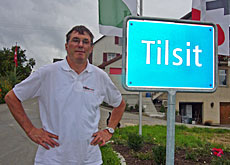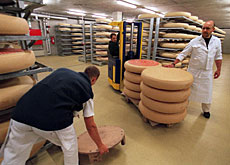Cheese smells of international incident

A Swiss farm has laid claim to a former Prussian place name – Tilsit - to protect the Swiss version of Tilsiter cheese from foreign competition.
The new Tilsit in the eastern canton of Thurgau is the home of the Wartmann family which has been closely tied to the cheese variety since 1893. That was when Otto Wartmann brought the recipe back from the original Tilsit in the former East Prussia.
Earlier this month, the Holzhof farmstead officially became Tilsit. The current Wartmanns took the decision after a Swiss cheese importer announced plans to import the Russian variety of Tilsiter cheese.
This was a wake-up call for the Tilsiter Switzerland organisation which markets the local product.
“We were alarmed, and started to think what we could do to make Swiss Tilsiter better known to ward off possible attacks. That’s when we had the idea of giving Tilsiter a home in Switzerland,” the current Otto Wartmann explained.
The original Tilsit was occupied by Soviet forces in 1945, and the remaining German-speaking cheesemakers expelled. The town was renamed Sovetsk, and – until Wartmann’s farm took the name – there was no longer a locality called Tilsit anywhere in the world.
In fact, as far as foreign competition goes, the Tilsiter organisation sees the greatest danger not from Russia, but from other European countries which also make Tilsiter or a similar variety of cheese, like Germany or the Netherlands: duties on agricultural products from the European Union were abolished on June 1.
But according to the Swiss, these are mass-produced products, whereas their Tilsiter is made in small local dairies and aims at a different market segment.
Smooth not crumbly
“He made a couple of adaptations,” Wartmann says of his great-great uncle. “He made holes round instead of slits. It’s nicer to look at like that. And he made it smooth, where the original was crumbly. But the size, shape and taste are the same.”
The idea caught on. Today Swiss Tilsiter is one of the country’s most popular cheeses, with high brand recognition.
“We won’t be able to tell for a couple of years how much competition we will get from abroad,” Bruno Buntschu, director of Tilsiter Switzerland told swissinfo.
“Personally, I’m not too worried. I think the biggest competition was from Swiss regional cheeses, and that’s already happened.”
The challenge from regional speciality cheeses first sprang up when the internal market was liberalised about ten years ago. Each is only sold locally, but taken together they account for a lot of sales.
It is therefore important for Tilsiter Switzerland to keep up its campaign. Every August 1 – Swiss national day – the renaming of the farm will be celebrated, and the title of master Tilsiter maker will be awarded.
Original Tilsit
The organisation will also work with the local tourist office to promote the site, and set up hiking and cycle paths leading to Tilsit. Historical documents – including a place-name sign from the original Tilsit – will go on show at the farm.
Exiles from Tilsit have formed their own associations in Germany. Some exiles addressed the Swiss event and their local newspapers published reports about it.
“We have had phone calls from people 80, 90 or 100 years old, saying they would like to visit if their health permits,” said Buntschu.
Tilsiter Switzerland is now considering plans to cooperate with the German exile organisation in Kiel to help fund projects in Sovetsk.
“It was a surprise for us how much emotion our event aroused among people who lived through what happened to the original Tilsit,” Buntschu commented. “It turned it into something much more than a marketing event. It gave it quite a new dimension “
swissinfo, Julia Slater in Tilsit
Tilsiter cheese has been produced in Switzerland since 1893, concentrated in the cantons of Thurgau, St Gallen and Zurich.
Most Swiss Tilsiter is produced by family enterprises, using milk from local farms. Tilsiter is a semi-hard cheese, with a reddish-brown rind. It is matured for up to six months. Each wheel is imprinted with a picture of a double cow.
The cheese took its name from the town of Tilsit, in what was formerly East Prussia.
At the end of World War II the original Tilsit was captured by the Soviet army and the German-speaking population driven out. Most now live in Germany. The town was renamed Sovetsk.
Tilsit is famous in history for the treaties signed there in 1807 between Napoleon and Russia and Prussia.

In compliance with the JTI standards
More: SWI swissinfo.ch certified by the Journalism Trust Initiative









You can find an overview of ongoing debates with our journalists here . Please join us!
If you want to start a conversation about a topic raised in this article or want to report factual errors, email us at english@swissinfo.ch.